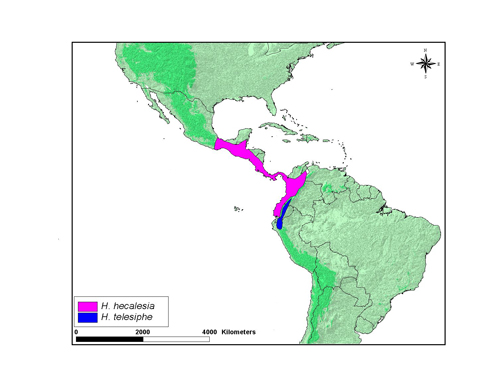Heliconius hecalesia
Margarita BeltránCharacteristics
Early stages: Eggs are yellow and approximately 1.2 x 0.8 mm (h x w). Females usually place 2 to 10 eggs on growing shoots of the host plant. Mature larvae have a dark green to brown body with long black spines, and black head; length is around 1 cm. Caterpillars are gregarious (Brown, 1981; DeVries, 1997). Pupae are slate grey with black markings, the thorax is strongly bowed and have short abdominal spines. The head has long head horns and the antennae have many short black spines (DeVries, 1997).
Adult: In Costa Rica H. hecalesia formosus is distinguished from its comimics hecale and Tithorea tarracina by the black hindwing apex, which has a row of spots within it, and a rounded forwing apex. Forewing length: 45-48 mm (DeVries, 1997).
Geographical Distribution
Heliconius hecalesia is distributed from Central America to Venezuela and Ecuador. The map below shows an approximate representation of the geographic distribution of this species. The original data used to draw these maps are derived from Brown (1979) which is available at Keith S. Brown Jr. (1979). Ecological Geography and Evolution in Neotropical Forests.
Habits
H. hecalesia occurs from sea level to 1,700 m in steep forests. Usually individuals fly rapidly and in the canopy. The males sit on female pupae a day before emergence, and mating occurs the next morning, before the female has completely eclosed. Adults roost at night in small groups 2 to 10 m above ground in twigs or tendrils (Brown, 1981).
Host plant: H. hecalesia larvae feed primarily on plants from the subgenera Tryphostemmatoides and Plectostemma (Passifloraceae) (Brown1981). In Costa Rica they utilize Passiflora biflora and P. lancearea (DeVries, 1997).
References
Brown K. S. 1981 The Biology of Heliconius and Related Genera. Annual Review of Entomology 26, 427-456.
DeVries P. J. 1997 The Butterflies of Costa Rica and Their Natural History, Volume I: Papilionidae, Pieridae, Nymphalidae Princeton University Press, Baskerville, USA.
Hewitson W. C. 1854. Illustrations of new species of exotic butterflies, selected chiefly from the collections of W. Wilson Saunders and William C. Hewitson. London, John Van Voorst. (9): [13-14], [25-26], [83-84], pls. [7], [13], [42] (2 January 1854), (10): [87-90], [97-98], pls. [44-45], [49] (3 April 1854)
About This Page

University of Cambridge, Cambridge, UK
Correspondence regarding this page should be directed to Margarita Beltrán at
Page copyright © 2010
 Page: Tree of Life
Heliconius hecalesia .
Authored by
Margarita Beltrán.
The TEXT of this page is licensed under the
Creative Commons Attribution-NonCommercial-ShareAlike License - Version 3.0. Note that images and other media
featured on this page are each governed by their own license, and they may or may not be available
for reuse. Click on an image or a media link to access the media data window, which provides the
relevant licensing information. For the general terms and conditions of ToL material reuse and
redistribution, please see the Tree of Life Copyright
Policies.
Page: Tree of Life
Heliconius hecalesia .
Authored by
Margarita Beltrán.
The TEXT of this page is licensed under the
Creative Commons Attribution-NonCommercial-ShareAlike License - Version 3.0. Note that images and other media
featured on this page are each governed by their own license, and they may or may not be available
for reuse. Click on an image or a media link to access the media data window, which provides the
relevant licensing information. For the general terms and conditions of ToL material reuse and
redistribution, please see the Tree of Life Copyright
Policies.
- First online 18 February 2007
- Content changed 12 August 2008
Citing this page:
Beltrán, Margarita. 2008. Heliconius hecalesia . Version 12 August 2008 (under construction). http://tolweb.org/Heliconius_hecalesia/72925/2008.08.12 in The Tree of Life Web Project, http://tolweb.org/








 Go to quick links
Go to quick search
Go to navigation for this section of the ToL site
Go to detailed links for the ToL site
Go to quick links
Go to quick search
Go to navigation for this section of the ToL site
Go to detailed links for the ToL site